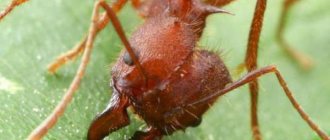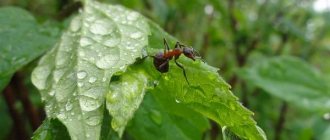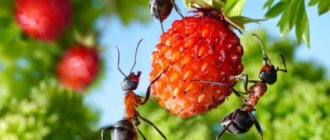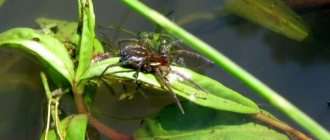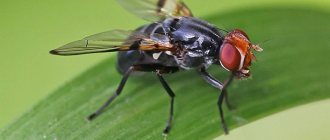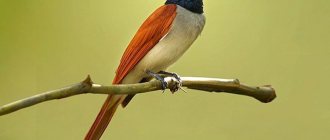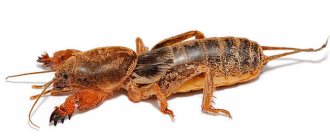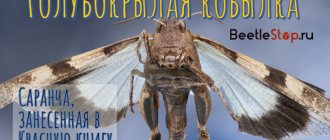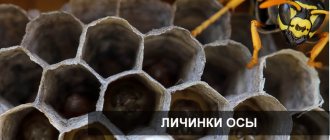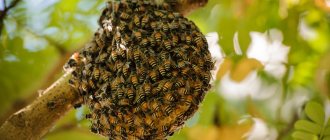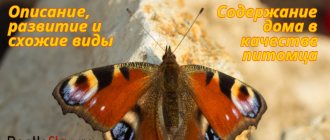People have been farming for thousands of years. However, compared to some representatives of the fauna, we are newbies in this matter. After all, leaf-cutter ants have been doing the same thing for millions of years.
Hardworking insect farmers can be found across a vast area of Central and South America, from Mexico to Argentina. Moving along its beaten path, each ant carries a fragment of a leaf three times its own weight. As common sense dictates, insects should feed on these leaves. But no. They use the leaves of trees and shrubs to grow their own mushroom garden! To support their production, leaf-cutter ants have evolved complex societies that are now the oldest and most advanced on Earth.
Common insects
These ants live in Central and South America. Their appearance is notable for the fact that on the muzzle there is a pair of large and strong jaws. They are hard and sharp, slightly curved inward. They have several notches on the inner edge. These devices help the leafcutter ant to gnaw the foliage of tropical trees. The head of this insect is large. That's how it should be. After all, it would be difficult to hold massive jaws on a small head. Leaf-cutter ants are not very large in size. They reach 5-20 millimeters in length. Their body color is brown. The uteruses differ in their size. They are large, with a wide, developed chest. There is a special pocket at the bottom of the leaf-cutter ant's queen's head. Before mating, she grows wings, and after it gnaws them off herself.
Roles of ants
The leafcutter anthill is inhabited by seven different castes, performing 29 different functions. Characteristic is the noticeable difference in size between ant castes. Individuals that perform the functions of caring for eggs, the farm and the queen in the anthill itself have a body length of only 5–6 mm. The size of the soldiers is impressively huge. The length of their body exceeds the size of working ants by 3–4 times, and their mass by tens of times. The largest individual in an anthill is the queen. Its mass is almost 700 times the weight of the smallest members of the colony.
Not every ant house has soldier ants at its disposal. Only very powerful colonies can afford such luxury.
original name
To better understand the process of creating a new colony of ants, we need to go back to why leaf-cutter ants got their name. Observing these insects, people concluded that they feed on plants. This happened because the leafcutter ant, common in America, destroys plant leaves. If the colony gets down to business, then in a short period of time only branches and a trunk will remain from the tree. What do they do with the leaves? Are eating? This assumption turned out to be incorrect. Yes, indeed, leaf-cutter ants, the description of which you will find in this article, chew leaves, but not in order to eat.
Your own vegetable garden
Their process of destroying foliage is very interesting. Some individuals trim the leaf from the cutting, then other ants approach it, specializing in gnawing out small pieces and dragging them into the house. Separate rooms of the anthill are reserved for growing mushrooms. And the leaves serve as a nutrient medium. To make mushrooms grow better, these insects use special fertilizers - their excrement, which they place on each leaf. But ants don't just eat mushrooms. They make sure they don't grow too big and trim them regularly. Then drops form at the site of the cut, which serve as food for them. The ants lick these drops, and their saliva, which contains large amounts of antibiotics, destroys harmful fungi and bacteria that can damage their mycelium. To ensure that the entire colony has enough food, these insects can grow about 100 mushrooms. Moreover, one weighs about 500 grams.
Diet features
Their diet consists only of mushrooms; they are not able to digest other types of plant and animal food.
In order to have enough food for the entire colony, they have to grow the mushrooms themselves, which is a process consisting of the following stages:
- There is a separate working caste that first finds a suitable tree with leaves and cuts them. These individuals have the longest legs, so they can easily climb to the very tops of trees.
- The leaves are then passed on to another caste of porters. These individuals are very hardy and strong, they carry prey to their home.
- At the next stage, when the leaves are brought into the anthill, they need to be processed. To do this, another group chews them to a pulp, this is how healthy fats are extracted, and the consistency allows mushrooms to germinate.
- After this, the pulp is mixed with the colony's excrement and other nutritious fertilizers, which are obtained by the goosebumps and spread on the farm. The placement of the nutrient mush is very important in this procedure; they lay it out in the form of long thin threads, which makes it easy to move.
- And a separate caste looks after the harvest; they make sure that their mycelium grows correctly and does not go beyond the farm. In addition, mushrooms must be processed so that harmful bacteria do not appear, and they do this with the help of saliva, which contains a natural antibiotic.
The workers chew the food and distribute it among all adult insects; the remains are fed to the larvae. When the entire harvest is harvested, the mycelium is carefully removed and cleaned for a new harvest. The anthill has a separate chamber where all the garbage is taken out.
Females are more important
The leaf-cutter ant, whose lifestyle is certainly interesting, also reproduces in an original way. To raise insects capable of reproduction, special individuals fatten the larvae, adding special substances to their food that stimulate sexual development. The females and males that grow from these larvae mate with each other. Moreover, the female needs a large amount of sperm, so she mates with several males. After mating, which lasts only one day, the males die.
Own house
The building of a new family begins with the departure of the female. She does not fly away with empty paws, or rather, jaws. In her special pocket, she takes away a piece of mycelium so that, having settled in a new place, she can begin to arrange new plantings. Having found a suitable place, the female digs a passage underground. There she makes a hole in which she plants the mycelium. She lays eggs nearby. Initially, she takes care of the children and the “garden” herself. Moreover, the female feeds on her eggs and partially born young. Over time, the ants grow up and begin to monitor the mushrooms themselves. Then the uterus retires. There should be one queen in one anthill. If she dies, then the workers begin to look after the eggs.
They'll definitely grow up
Having seen the larva of a leaf-cutter ant, the description of which you have already become familiar with, you would never say that it will grow into a strong ant. She looks like a little white worm. She has no eyes, no limbs, and without special care she will die. Moreover, for proper growth and development, it is necessary to monitor not only the correct feeding of the larvae, but also the conditions in which they are located. Air temperature and humidity must be maintained at a certain level. The ants feed the larvae with their own eggs, gradually transferring them to mushrooms. Interestingly, unfertilized eggs grow into males. Of the fertilized ones, there are females that will eventually become workers or queens.
What is the basic description
Leaf cutters are advanced ants. Of interest to scientists. The main characteristics, depending on the stage, are presented in the table.
| Larvae | The larvae are legless and eyeless. For full development, the representative needs a comfortable temperature and a specific level of humidity. Unfertilized eggs develop into males. Depending on the conditions, fertilized eggs produce queens or infertile females. In the absence of the opportunity to create new offspring, the representative will act as a worker and take care of the anthill. Mushrooms serve as food for the larvae. |
| Adult ants | Working ants with a body length of up to 20 mm. The size of the legs directly depends on the caste of the insect. A characteristic difference is the presence of a powerful hooked jaw. This is necessary for easy cutting of dense foliage. The ant has a large head. There is a well-developed sting. There is a special pocket on the bottom of the head. This is necessary in order to stock up on mycelium. The uterus has wings. However, they are nibbled off before the immediate formation of a colony by the most fertile female. |
Insects are divided into 7 castes. Among leaf cutters there are:
- uterus;
- males;
- soldiers;
- foragers;
- builders;
- gardeners;
- small workers.
The roles in the anthill are very carefully separated
Workers are responsible for caring for new offspring. Perform work in mushroom beds. The body does not grow more than 0.5 cm. Larger builders. The body length of some representatives can reach 2 cm. The head is powerful and large.
The largest uterus. The weight of the female is several times greater than that of ordinary working leaf cutters. There are powerful and large breasts. All ants of this species have 3 pairs of long limbs.
That's how they live
Scientists have studied what an ants' home looks like. It even became known why they build it underground, and not on trees, closer to the leaves that they need so much. The fact is that deep in the soil there are almost no temperature changes that can be dangerous for growing mushrooms. Also, in such conditions, the mycelium is protected from high humidity, which has a detrimental effect on it. To understand how the house of leaf-cutter ants works, you need to imagine a giant egg in cross-section. The safest place is in the center. This is where the chamber in which the uterus lives is located. This cell is surrounded by special children's "rooms". It is in them that larvae are raised from eggs. Mushrooms are grown in the outer chambers. Interestingly, some leafcutter ants clean their homes and take trash outside. Others put it in special garbage “rooms”.
How are leaf cutters' homes arranged?
Individual colonies of leaf-cutter ants can last for years and contain more than 2-3 million insects.
Ant nests can often be seen along roadsides, in open fields, in bushland or in forests. Typically they are located on well-drained sandy or loamy soils. Anthills can be quite large, ranging from 15 to 25 meters in diameter. In areas where leaf cutters are especially numerous, it is difficult to distinguish where one colony ends and another begins.
Above ground, the nest is marked by numerous crater-shaped mounds ranging from 12 to 35 cm in height and 30 to 45 cm in diameter. Each “mound” has a central entrance hole. Above the underground central nest cavity, several entry holes are marked by typical crater-shaped mounds and soil accumulations. On the plains these mounds are immediately noticeable.
Under the ground, the nest consists of several chambers, the depth of which can reach 4-6 meters. All chambers are connected to each other by narrow tunnels. Vertical tunnels extend to openings in the mounds, while lateral tunnels can lead outwards for distances of up to 150 m. The complex structure of cavities and tunnels allows ants to escape from predators underground and provides an effective air circulation system.
Activities to your liking
Interestingly, different individuals of ants perform different functions. Among them are those who take care of the queen, the house, and the farm. Others guard the anthill and extract leaves. Moreover, these insects even differ in size. The smallest ones are worker ants. The largest is the uterus. It weighs 700 times more than a small individual. But not every colony has soldiers. Only the largest and most powerful ones have security. Interesting insects are leaf-cutter ants. "What are they needed for?" - someone will be interested.
Teleportation of Atta Ant Queens
Queens of this species have the unique ability to teleport. Scientists built a strong chamber for the queen and made a mark on the queen. The amazing thing is that the uterus can disappear from a closed chamber in a few minutes. It can be found in another chamber of the anthill. No one knows how she managed to escape from the very strong cell.
This phenomenon was described by a cryptozoologist named Ivan Sanderson. Most myrmecologists - ant specialists - cast great doubt on this theory.
Difficult pests
At first glance, it seems that these insects cause only harm. Indeed, if there are too many of them, perhaps they will be able to eat the entire forest. That is, over time they will turn our planet into a desert. However, this does not happen. Apparently, nature itself maintains a certain balance. After all, leaf-cutter ants have natural enemies that prevent them from spreading too much. People also fight these insects, preventing them from approaching cultivated crops. To do this, their nests are destroyed using chemicals, and metal, plastic or water barriers are installed around the trees. Under natural conditions, the underground activity of leaf-cutter ants even contributes to the enrichment of soil layers and the acceleration of metabolic processes in the ecosystem. In addition, leaf-cutter ants themselves have become food for humans. Fried insects have long been eaten in South America and other countries.
Nowadays, we don’t have any kind of pets! For some people, these are leaf-cutter ants. Of course, they do not live in a garden plot, but in special insectariums in which special conditions have been created. These insects are interesting to watch, but still they must live in their natural habitat. If you are not planning to travel to South America anytime soon, you can see leaf-cutter ants at the Moscow Zoo.
